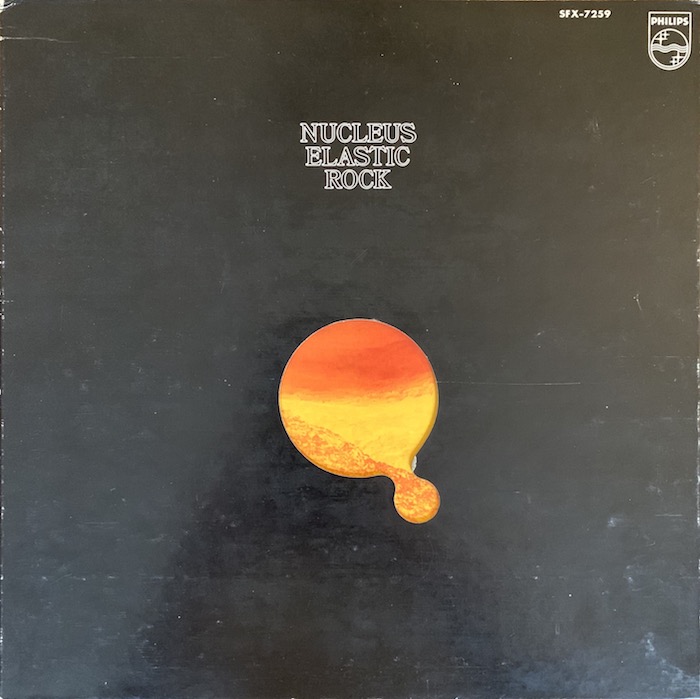
The year before The Ahmad Jamal Trio performed their composition ‘Bogota’ at the Montreux Jazz Festival in Switzerland, a small group of British musicians by the name of Nucleus showcased compositions which pioneered a new sound, one that blended jazz with influences from rock and funk, now defined as ‘jazz-rock’ or ‘fusion’. This radical new approach to jazz saw the group win first prize at the festival and was responsible, along with a few other notable albums, in ushering jazz away from the modal and post-bop sounds of the 60s and into the psychedelic, funky fusion of the 70s.
Earlier that year, Nucleus had released their debut album Elastic Rock (1970) on British label Vertigo, known for its progressive, psychedelic and jazz-inflected releases. The group was an accomplished band of musicians who all had roots in the British jazz and Canterbury music scenes of the late 60s and early 70s. The group was led by Ian Carr, a self-taught trumpeter who had already made a name for himself for his work with British saxophonist Don Rendell during the 60s, where the two of them released a series of albums which have since become legendary landmarks in the history of British jazz, original copies which now fetch eye-watering prices!
The track ‘Torrid Zone’ is arguably the high point of the album, an eight minute long composition, where the group stretch out and develop this idea of ‘elastic rock’. Any jazz fans will immediately notice similarities with the music of Miles Davis, most notably his albums In A Silent Way (1969) and Bitches Brew (1970), both of which are generally heralded as being the start of jazz fusion. However, interestingly, Elastic Rock was recorded before Bitches Brew was released and Carr claimed that the group had not yet heard Miles’ In A Silent Way. As critic John Kelman has rightly pointed out, this suggests that ‘advances in music come from many sources and usually at the same time’.
Kelman also notes the difference in approach taken by Miles and Nucleus. Whilst Miles’ compositions on In A Silent Way and Bitches Brew focus much more on riffing around one musical idea for extended periods of time, often to hypnotic effect, Carr and his band pursue a more lyrical approach with a focus on melody and harmony. In an interview with Norwegian TV in 1974, Carr mentioned how Nucleus’ approach to music-making was a question of balance, occupying the space between ‘Western art music’ (Classical music) and ‘non-Western music’, opting for an approach which didn’t fall into the trap of become too groove-centric or on the other hand becoming overly abstract and boring. ‘Torrid Zone’ moves through various musical passages and leads the listener on a journey with its musical ideas and solos. The music is deep, psychedelic, spiritual, funky and soulful in equal measure. Also particularly interesting is the role ‘Torrid Zone’ plays as part of the album as a greater whole. The track seamlessly moves into the next track on the album ‘Stonescape’ and the melodic ideas heard in ‘Torrid Zone’ are soon revisited on the modal ‘Earth Mother’. Elastic Rock is therefore best consumed as a whole album from start to finish for maximum effect.
The end of the 60s and the early 70s saw the boundaries between jazz and other musical genres become increasingly blurred as rock musicians looked to jazz for inspiration on composition and improvisation and jazz musicians to rock with the intention of capturing some of the energy inherent in the popular rock sounds of the time and consequently expanding their audience. As Carr himself said, jazz and rock musicians ‘have the same common origins’ with roots in blues, boogie woogie and American gospel. The term ‘torrid’ is defined as ‘giving off intense heat’ and so is a fitting description for the fiery compositions Nucleus unleashed on their unsuspecting audience in that summer of July 1970, and was a catalyst for the seismic shifts in both jazz and rock that followed.
Discover more music from Nucleus and other British jazz musicians in our ‘Best Of British Jazz’ playlist over on Spotify or for more 70s fusion goodness, throw on ‘Fusion Intrusion’.
If you enjoyed this post and want to stay updated, make sure to subscribe to our Spotify playlist and follow us on Instagram and Twitter!
